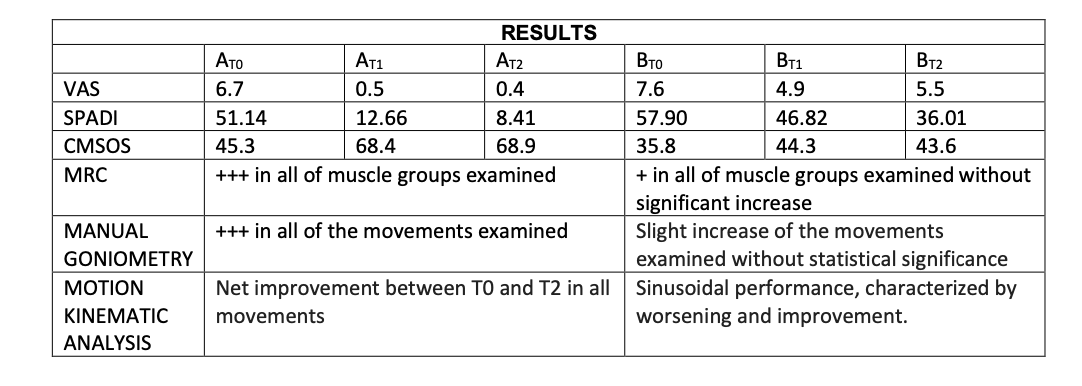Arone Basilio (Physiotherapist, Intensive Rehabilitation Clinic “Villa Elisa”, Cinquefrondi (RC) Italy)
Napoli Vincenzo (Physiotherapist, Intensive Rehabilitation Clinic “Villa Elisa”, Cinquefrondi (RC) Italy)
Surace Alessia (Physiotherapist, Intensive Rehabilitation Clinic “Villa Elisa”, Cinquefrondi (RC) Italy)
The study was developed to compare short – term and mid – term efficacy between therapeutic exercise coupled with viscosupplementation and viscosupplementation only in patients with moderate to severe gleno – humeral osteoarthritis.
20 patients over 45 years of age, pain over 6 months and less than 5 years, VAS> 4, and grade II-III Kellgreen – Lawrence were selected. They were subdivided randomly and assigned to group A (Hyaluronic Acid + Therapeutic Exercise) and Group B (Hyaluronic Acid). Exclusion criteria were adhesive capsulitis, extra – articular syndrome, complete rotator cuff injuries, Hyaluronic Acid allergy, IV class Kellgreen – Lawrence osteoarthritis, previous steroid infiltration and rheumatoid syndrome. Before starting the rehabilitation program, specific assessment scales (SPADI, CMSOS, MRC, VAS, Manual Goniometry and Motion Kinematic Analysis) were administered. B group patients were immediately administered intra – articular high molecular weight Hyaluronic Acid. To Group A patients, in addition to high molecular weight Hyaluronic Acid was administered a Therapeutic Exercise Protocol of 30 days, divided into 4 phases, including passive mobilizations, active – assisted exercises, isometric exercises, functional (isotonic and eccentric) and proprioceptive exercises.
The results of the assessment scales of two groups were compared before to start rehabilitation program (T0), at short – term (T1 – 30 days) and at mid – term (T2 – 90 days). With good statistical significance (p <0.01 U p <0.05), Group A showed sensible improvements over Group B in all of investigated items. The most important improvements were shown in the time period between T0 and T1, where therapeutic exercise was performed.
At 90 days, Group A patients have maintained gained performance and continued to improve, though statistically unimportant, while Group B patients began to get worse again.
